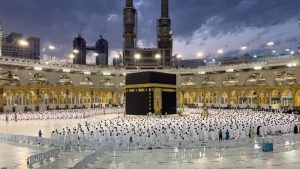Rami al-Jamarat, an important Hajj ritual, is a rite performed by Hajis in Mina. In this ritual, small pebbles are thrown at three pillars in Mina. This act of throwing stones at the devil is known as ‘Rami’. In this comprehensive guide, we explore the significance of Rami Al-Jamarat during Hajj and how affordable Hajj Packages for 2024 facilitate this essential ritual for pilgrims.
Three Jamarat (Pillars)
Pelting devils is the thirteenth obligation of Hajj. There are three Jamarat (pillars) which are known as:
- Jamarah Al-Aqaba or Jamarah Al-Kubra, the big pillar
- Jamarah al-Wusta, the medium or middle pillar
- Jamarah Al-Ula or Al-Sughra, the smaller pillar
The distance between the first and second pillars measures around 150 meters, while the distance between the second and third pillars is approximately 120 meters.
The Jamarat represent the three places where Shaytan attempted to distract Ibrahim (AS) from following Allah’s order he had received. Therefore, the pillars do not represent the actual Shaytan, as some people may believe, but rather serve as markers of where Ibrahim was tested by the whisperings of Shaytan.
In 2005, each pillar was reconstructed and transformed into massive wall structures. Prior to this, the structures were tall and thin. This new design of the pillars makes performing Rami much simpler, as the target is now much larger. Affordable Hajj Packages 2024, ensure pilgrims perform Rami easily by including experienced guide in their Hajj Packages from US.
Days of Rami Al-Jamarat
The ritual of Rami is the reenactment of Prophet Ibrahim (AS); when he was obeying Allah’s order and was about to sacrifice his son Ismail (AS), the devil tried to change the mind of Prophet Ibrahim (AS). While trying to avoid the devil, when Ibrahim (AS) reached Jamarat Al-Aqaba point, Angel Jibreel instructed Prophet Ibrahim (AS) to throw seven stones at the devil. As soon as Prophet Ibrahim (AS) threw stones, shaytan fled immediately. Devil tried three times to dissuade Ibrahim from obeying the order of Allah. The three Jamarat indicate the three places where devil tried to distract Ibrahim.
Narrated in Sahi Muslim
Jabir ibn Abdullah reported:
“Allah’s Messenger PBUH flung pebbles at Jamarat on the Day of Nahr after sunrise and after that (i.e. on the 11th, 12th and 13th of Dhul Hijjah when the sun had declined.)”
According to this hadith, Rami (stoning the devil) is performed on:
- The Day of Sacrifice (Yawm Al-Nahr) – 10th of Dhul Hijjah
- Ayyam Al-Tashreeq – 11th, 12th and 13th of Dhul Hijjah
On the 10th of Dhul Hijja, only the Rami of the big pillar (Jamarah Al-Aqaba) is performed. It is recommended not to pelt the other two pillars on the 10th of Dhul Hijjah, although no penalty is due if anyone performs Rami of the three pillars on the 10th of Dhul Hijjah. While on Ayyam Al-Tashreeq Rami, of all pillars or the rest of the two pillars is performed on each day, start pelting from the smallest pillar to the largest. However, changing the order won’t cause a penalty, nor it is necessary to repeat the ritual. Knowledge guides included in Affordable Hajj Packages 2024 ensure pilgrims have complete insight into this important Hajj ritual.
Best Time to Perform Rami Al-Jamarat
It is crucial to perform Rami within the allotted time; ignoring the time restriction is strictly prohibited, and a penalty will be due. The timings for stoning the devil are as follows
- 10th of Dhul Hijjah – After sunrise till zawwal (Sunnah Time) After dawn till sunrise (Makrooh time)
- 11th & 12th Dhul Hijjah – After zawwal till sunset (Sunnah time) After sunset of the 11th & 12th till dawn of the 12th/13th
- 13th of Dhul Hijjah – After zawwal till sunset (Sunnah time). After dawn till zawaal (Makrooh time)
Pelting on the 13th of Dhul Hijjah only becomes compulsory if one is present in Mina before sunrise on the 13th of Dhul Hijjah. Affordable Hajj Packages 2024 includes a Hajj guide to ensure pilgrims follow the schedule to pelt Rami at the best time to avoid crowds. These Hajj Packages from US design scheduled rituals to ensure pilgrims perform each rite at their best time. Affordable Hajj Packages 2024 prioritizes offering Rami in the evening due to low crowds in the evening.
Walking to the Jamarat
The location where the Jamarat ritual takes place is situated at the far end of Mina, closest to Makkah. Pilgrims staying in Mina camps access the Jamarat site through a network of tunnels. These tunnels are spacious and well-ventilated, providing pilgrims with a convenient and comfortable route to the site. Affordable Hajj Packages from US, with a deep understanding of the needs of our elderly pilgrims, prioritize their comfort and safety by offering wheelchair access for navigating the tunnels or providing bus transportation to reach the Jamarat point.
Conclusion
Rami Al-Jamarat is an important Hajj ritual that symbolizes the rejection of the temptations of the devil (shaytan) and steadfastness of faith. Affordable Hajj Packages 2024 play a crucial role in ensuring pilgrims perform this ritual without delay at the scheduled time. These Hajj Packages from US are designed meticulously so that a wider range of Muslims can perform Hajj without financial burden. Through knowledgeable guides, ample time for reflection, and a sense of unity and community, pilgrims securing affordable Hajj Packages 2024 find fulfillment and contentment in performing various Hajj rituals. If you are pelting on someone’s behalf, make sure you are allowed to do so. If you miss the Jamarat or you are unsure whether you hit the target, throw again. May Allah guide us and strengthen our Iman.










